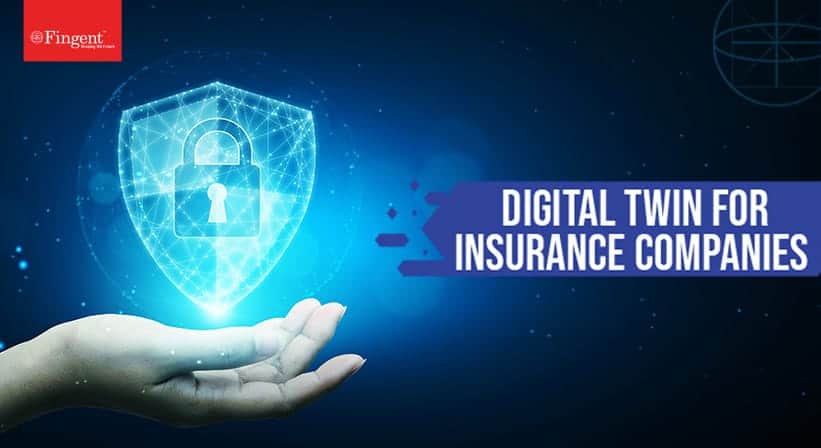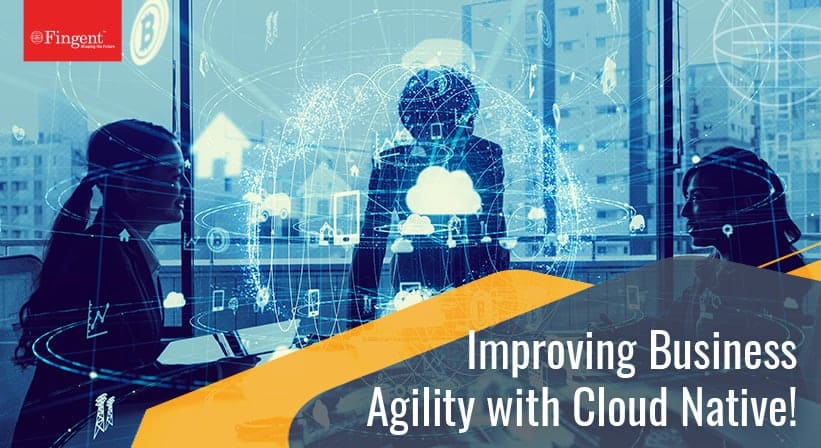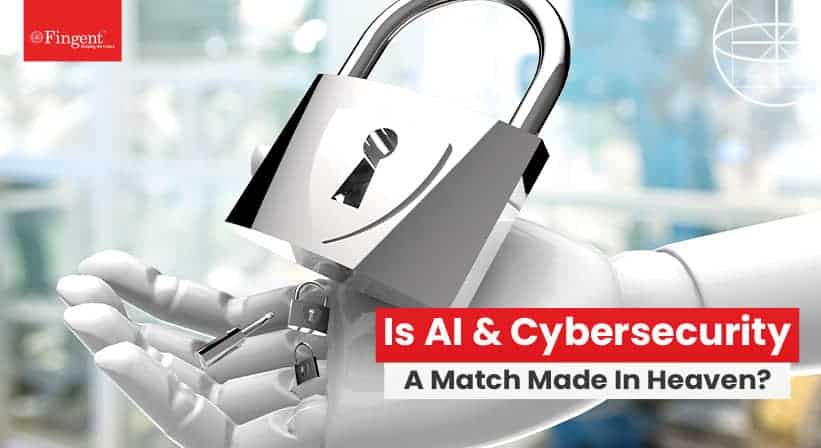Tag: SAP solutions
Choosing between SAP Business One and SAP Business ByDesign
Technology is constantly evolving to introduce better and more efficient ways of doing business. Manual and traditional spreadsheets are no longer the best way to do things. Most businesses are recognizing that technologies like ERP software are more robust when deployed over the cloud. This has got them looking for digital solutions to automate their processes. This is where SAP comes into the picture.
Growing businesses looking to streamline their business process are turning to SAP, which offers several solutions including SAP Business One and SAP Business ByDesign. With an ever-increasing choice in the ERP market, you might wonder how you can choose from all the different offerings and what is the difference between SAP Business One and SAP Business ByDesign. This article will walk you through the differences between these solutions. It will also help business users and decision-makers choose the perfect ERP solution that fits their business needs.
Read more: What is Business Process Expertise in SAP and Why You Need it
Let us begin with an overview of both platforms.
Overview of SAP Business All-in-One Solution (B1)
SAP Business One has been around for many years and has been the go-to product for small businesses. It is an on-premise system built on SAP ERP application. It addresses the fundamental business software requirements of all types of industries. These solutions provide support for your business. With it, you can win a new customer, make innovative products, and reconcile your accounts. SAP Business One is proven and comprehensive with built-in industry best practices.
Starting from production to distribution, SAP Business One (B1) promotes transparency at every step of the business. SAP B1 powers business growth by tapping into your personalized data to offer actionable insights. SAP Business One solution focuses on streamlining workflows and reducing costs.
It helps integrate a spectrum of business processes into a single solution to optimize your business performance. SAP B1 offers modules for financial management, reporting, accounting, analytics, customer management, purchasing, inventory management, and industry-specific versioning.
Overview of SAP Business ByDesign (ByD)
SAP Business ByDesign is cloud-based. It is designed for mid-market businesses and subsidiaries. It is perfect for those who wish to leverage the benefits of large-scale business management applications without the need for maintaining a larger IT infrastructure. SAP Business ByDesign unifies multiple business operations. It enables companies to incorporate business processes that can solve immediate problems and then add processes as required.
SAP Business ByDesign (ByD) is delivered through a single user interface. It can deliver pre-configured software for business processes. Additionally, it can support best practices for managing customer relationships, human resources, financials, projects, procurements, and the supply chain. This cloud-based ERP solution is delivered on-demand. It is monitored, managed, and maintained by SAP experts in cloud-hosted data centers. As a result, businesses need not worry about the upgrade and maintenance of the solution. Also, this does not require an up-front capital cost.
Read more: SAP Preconfigured Solutions Boost Efficiency Among Industries
SAP Business One (B1) vs. SAP Business ByDesign (ByD)
While these two might seem like twin solutions, they have some important differentiating factors. Let us look at these factors so that you can determine which fits better for your business.
1. Customers
SAP B1 typical customers include businesses that are from the manufacturing, distribution, basic retail, eCommerce, and service industries.
SAP ByD customers range from manufacturers who create products or processes to professional service firms who are looking to automate their business processes in real-time. Other sectors include life sciences, financial services, and fintech.
2. Size of the organization
SAP B1 is basically designed for small businesses. It has a minimum user limit. This solution is ideal for small to mid-sized organizations that need a step-up from a basic accounting solution. The sweet spot for SAP Business One is 5-50 users.
SAP ByD is best for upper mid-sized companies with a minimum number of 5 users. It suits businesses that are looking to scale as well as the enterprise subsidiaries. The sweet spot for SAP ByD is 20-1500 users or more.
3. Features
SAP B1 offers a lean set of modules that make up the core of ERP. It streamlines business processes end-to-end and is deployed on-site and runs on Windows OS. SAP B1 allows companies to add custom functionality. Users can manage sales, inventory, finances, production, and services. Companies can also use it for procurement, CRM, basic project systems, dashboards, embedded analytics, and basic multi-company functionality.
Read more: Tackling healthcare data challenges with SAP Analytics
In addition to all the features of SAP B1, SAP ByD offers multi-level bills of material, which makes it easy to manage project systems and allows you to incorporate multiple companies under a single instance. SAP ByD also offers a mobile app, travel expense fields, timesheet integration, and a built-in workflow to assist your employees to stay on task. SAP ByD streamlines business operations such as transactions, ordering, and logistics from end to end in real-time. It facilitates interactions between various departments and between enterprise branches.
SAP ByD enables you to customize your package to include the features your company needs. It facilitates real-time interactions. That means you can check your inventory and orders whenever you need it. This solution can be implemented in a matter of a few weeks.
4. Budget
The implementation target budget of SAP B1 ranges between $40k (simple) to $200k (complex) with the total package costing up to $1,700 for limited users and $3,700 for professional users. Apart from the cost of implementation, companies will have to spend money on the software license, hardware, IT support, security, and infrastructure. A company’s deployment options determine if their hardware and support requirements should be assigned to a cloud solution provider.
The implementation target budget of SAP ByD ranges between $50k (simple) to $200k (complex) with the average user cost at $80/mth/user. Apart from the implementation cost, clients are expected to pay for an annual subscription fee and any other optional technical support.
5. Deployment
SAP B1 is an on-premise application that is also available in the intranet cloud. However, it is not a complete SaaS application. Certain features such as Microsoft Outlook will work only through the Microsoft Outlook Integration add-On for SAP Business One.
SAP ByD is completely cloud-based and so it can help companies connect every function across their business.
6. Security
Since SAP B1 is hosted on-premise data center, the client is responsible for security. Because the data does not have to travel via cloud, it may be less vulnerable to remote hacking. However, it is more susceptible to a physical attack or espionage on your premises. It is not as safe and secure as SAP’s data centers.
Since it is a Saas system, the responsibility of security rests on the vendor. SAP ByD is hosted in a highly secured data center. It has the best data security centers with excellent security measures including advanced encryption standards and bulletproofing.
7. Implementation
SAP B1 does not support multi-company implementation. It is not possible to have an entity-specific data or entity-specific chart of accounts.
Whereas SAP ByD can maintain organizational structure, run subsidiaries and overseas branches with a single system. It is possible to have entity-specific charts of accounts.
8. Integrations
SAP B1 can be integrated with anything. However, it requires expertise and additional cost to do so. For an intercompany functionality, you will need an add-on. This means users will have to switch databases when they access information from another legal entity.
SAP ByD is a unique solution that offers over 200 pre-built integrations. It is a real multi-company solution. With intercompany capability built-in, SAP ByD can facilitate single-sign-on to offer visibility across various legal entities.
9. Industries
Manufacturing, trading, retail, distribution, eCommerce, and service industries are best suited for SAP B1.
SAP ByD fits companies that are involved in distribution, manufacturing, construction, software, IT, consulting, pharmaceuticals, chemical, medical and service industries.
Read more: SAP Focused Industry Templates & Automation Solutions
10. Financials
SAP B1 does not allow multiple account charts for one company and neither does it allow linking them with accounting charts. This solution lets you create just one posting period for one company. It does not offer different methods of revenue recognition. Though this version has built-in analytics, not all options are available. In purchasing, SAP B1 provides a direct invoice after receiving goods from the vendor. However, since it does not save the information of that invoice, there is no way you can resolve any discrepancies that occur at a later period.
SAP ByD allows multiple accounting charts for one company and you can link them with financial books and transactions. This solution lets you have different financial periods for different financial books. Additionally, you can generate financial reports based on these periods. SAP ByD supports different accrual methods for different sales documents. This version offers built-in analytics such as margin information from sales. In purchasing, SAP ByD provides an invoice receipt concept to confirm the invoice from the vendor. That invoice is then saved in the system before booking the final voice. This allows companies to resolve any discrepancies that arise at a later point.
Read more: Business Continuity Planning with SAP
What is the verdict?
SAP B1 and SAP ByD are two excellent and well thought out solutions. As discussed, they have a few differentiating factors that can help you choose between them. The best solution for you depends on the size, structure, and growth potential of your organization. A business with a simplified management structure and a more limited growth plan is better suited for the SAP B1 platform. However, a business that is on an accelerated growth plan with multiple operating subsidiaries would better suit SAP ByD. This is because it has the ability to expand quickly with greater functionality and capability.
We enable e-invoicing integration for SAP users to stay compliant with GST India regulations. Click here to explore
Regardless of whichever solution you chose, ensure to test your ERP system before you go live. Even after you go live, you can continue to optimize the technology’s features. We offer customized SAP solutions ranging from core ERP to innovative and intelligent solutions such as SAP S/4 HANA, SAP Leonardo, SAP Analytics Cloud, SAP Customer Experience, and more.
Fingent can help you make the right choice as well as implement it seamlessly for your business. Get in touch with us and let’s get the conversation started.
Stay up to date on what's new

Featured Blogs
Stay up to date on
what's new



Talk To Our Experts
Empowering CFOs to Derive Crucial Insights and Implement Strategic Decisions with Confidence
The role of the CFO is no longer restricted to fulfilling traditional financial duties. With advances in technology, the CFO’s responsibilities are also growing as today’s CEOs and boards demand the finance function provide real-time, data-enabled decision support. The present-day CFOs and their teams serve as gatekeepers to critical data that is required to generate forecasts and support business leaders to make strategic decisions that have a lasting impact.
With that said, what are the challenging areas for CFOs where they can perform better with the integration of the right technology? We’ve tried to list out a few here.
Key Challenges Faced by CFOs
1. Insights
- Acquiring self-service analytical capabilities to garner strategic and operational insights for reliably enabling key decisions and enhancing visibility through the board-room to the shop floor.
- Addressing big data requirements is another challenge. Embedded data analytics that connects transaction executions with immediate insights and analyses is a must-have weapon in the CFO’s armor. With automatic matching capabilities, finance professionals can reduce the time taken to gather data.
- Predictive insights are essential to assess future outcomes. CFOs equipped with predictive analytics capabilities empower organizations through powerful budgeting, planning, and forecasting that will drive the business on the right path.
2. Ensure agility to respond, adapt and survive
- It’s always at the top of a CFO’s agenda to optimize risk management and establish a sustainable cost-effective control environment. A sustainable compliance program (compliance-first approach) can free up to 30% of the function’s capacity while keeping the risks low.
- Structure finance to make the most of tight budgets and provide financial support for corporate initiatives by ensuring discretionary expense management and operational costing optimization.
- Increasing adoption of “Shared Services model” (service delivery models under centralized and decentralized structures) for enterprise operations allows businesses to expand to several domains, customers, products, geographies, and channels. For CFOs, this translates to more challenges w.r.t. strategic pricing, customer and product profitability modeling, and profitable growth target setting. CFOs also need to cater to multiple businesses and stakeholders while supporting all the current and evolving business models.
- Embedded localization requirements to best-balance the risk and efficiency and implement best practices supporting operations across segments, industries, and geographies.
- Flexible deployment models allowing the optimal combination of cloud and on-premise solutions.
3. Optimize costs, digitize finance, and other functions
- CFO and other finance professionals are expected to offer more value-add solutions that provide strategic direction for the enterprise. Automation of repetitive, rule-based finance functions enables CFOs and financial professionals to focus more strategically.
- CFOs need to gain improved visibility across all cost components that allow them to take quick actions such as cutting unwanted costs and justifying new costs in a tangible way.
- Integrate and unify all corporate processes allowing for a higher level of standardization. This can only be achieved with an intelligent enterprise technology like SAP S/4HANA.
Why is SAP S/4 HANA ideal for CFOs?
Traditional ERP systems store data in many different tables. As a result, financial teams struggle with isolated and inconsistent information from many sources. They end up spending hours sifting through data and compiling reports manually. Despite this, they are unable to provide the desired financial insights. On the other hand, SAP S/4 HANA stores all financial information in a single Universal Journal. It is a powerful concept that eliminates redundancy and creates a single source of truth. This gives you easy access to accurate, timely, and qualitative information. Your business processes become transparent and reliable.
The broad portfolio of new technologies and innovations in SAP S/4 HANA Finance empowers CFOs with responsive decision-making tools. These tools give you instant insights into all the company’s data and systems. You can perform end-to-end analyses right from the boardroom to the shop floor.
Read more: How SAP S/4HANA transforms the end-to-end business process
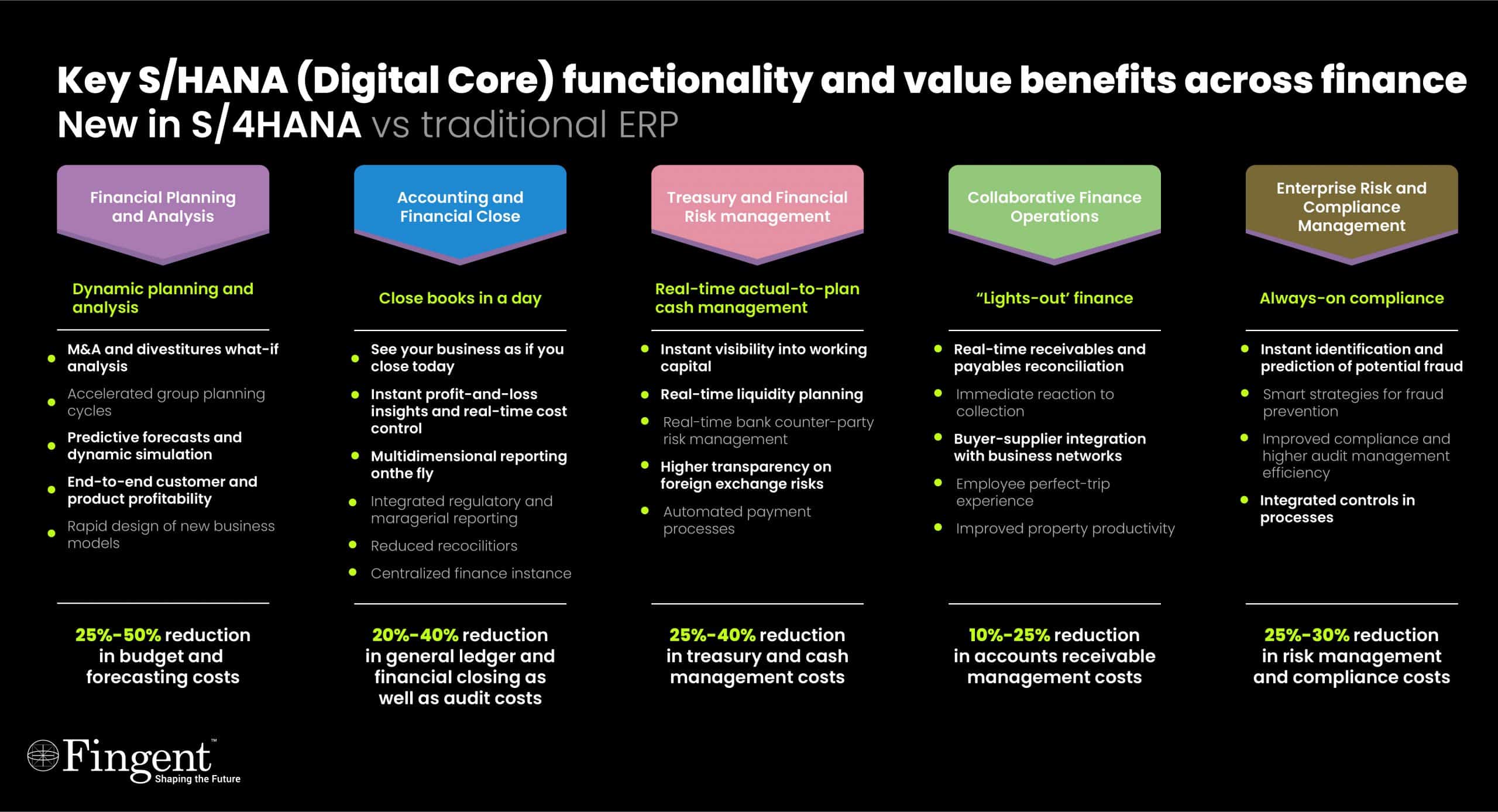 (Click to enlarge the image) Source: SAP
(Click to enlarge the image) Source: SAP
Embedded Analytics
Organizations using ERP systems have always found that while it’s easy to enter data into the system, getting interesting information from it is tedious. SAP S/4 HANA Finance enables direct reporting without the need for a data warehouse for specific analytic requirements. This is possible because of the Universal Journal. However, this alone does not deliver the right insights. This is where Embedded Analytics in S/4 HANA comes in.
Embedded Analytics allows not only the intuitive navigation through graphical views but also the close integration of analysis capabilities within the operational transactions. This makes it easy to act directly on the right information without having to switch between screens or systems. It has business planning, consolidation, and forecasting capabilities which can help you gain new insights from different perspectives.
The embedded analytics in S/4 HANA is also helpful to determine the best course of action when unprecedented disruptions occur. Thus, the role of the Office of Finance transforms from mere historical reporting to analyzing business performance.
Read our case study: Find out how Fingent automated integration between SAP SuccessFactors and SAP S/4HANA
Predictive Capabilities
Organizations need accurate financial insights to steer their business in the best path. In the past, decision-makers requested information through month-end reporting. That practice is long gone. Today, continuous delivery of relevant information is the minimum requirement. More insights are requested on what the future would bring. This is where Predictive Accounting can help.
For example, when a sales order is confirmed in the system, it is not recorded in accounting until you deliver the goods and send an invoice. With Predictive functionality based on the sales order, a predictive invoice is registered. When the actual invoice is sent out, the predictive posting is back-posted, reducing the predicted amounts. This predictive accounting logic can help you simulate financial postings based on the confirmed incoming sales orders. You end up getting an accurate and futuristic view on your margin.
Read more: How SAP Helps Manage Your Payroll During COVID-19 Crisis
Transforming Finance into an Intelligent Portfolio
The S/4 HANA digital core offers predictive analytics combined with machine learning across various lines of businesses (LoBs). SAP Cash Application is the first Lighthouse application that is based on SAP Leonardo Machine Learning. It analyzes the customer’s historical data, learns which matching criteria are important, how to prioritize them, and how to best apply them using machine learning. This helps to intelligently match payments to open receivables and automatically clear those items minimizing manual effort. Thus, we process cash faster, improving the days of sales outstanding.
Read more: Unlock the Potential of Intelligent Enterprise with SAP Leonardo
In other words, finance teams can scale as the business grows and save time to focus on strategic business tasks like growth and planning. The machine learning application is cloud-based and non-disruptive to the system-of-record. As it is tightly integrated with SAP S/4HANA, you can easily adapt innovations without having to resort to costly and time-consuming IT projects or any risky activities in your back-end system.
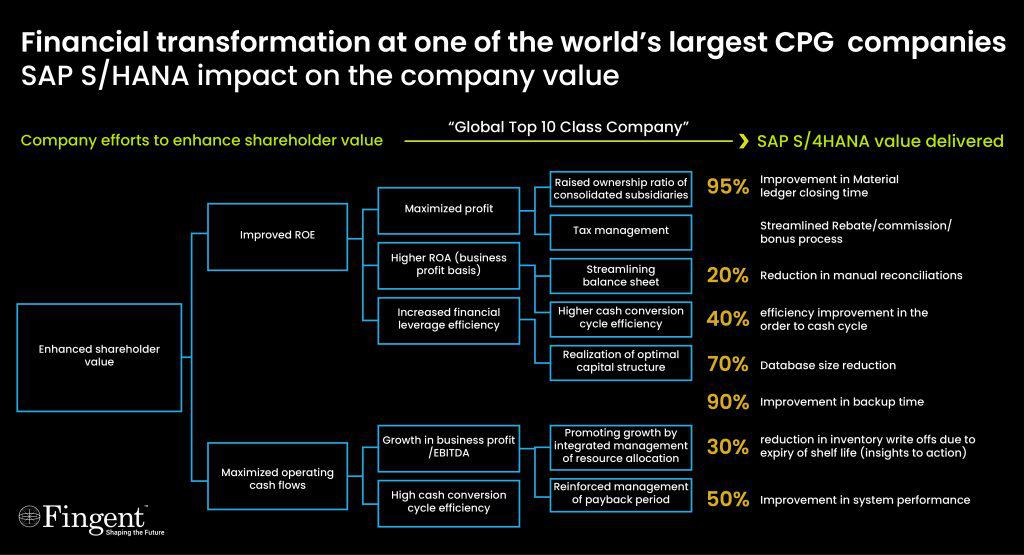 (Click to enlarge the image) Source: SAP
(Click to enlarge the image) Source: SAP
Take Your Next Step with Fingent
SAP S/4 HANA supports CFOs by using business processes that are already available within the S/4 HANA environment. As CFOs grapple with new disruptive business models, SAP S/4 HANA Finance can help them in their decision-making process at a tactical and strategic level. Leveraging these technologies can enhance the organization’s ability to pivot quickly and adapt to dynamic business scenarios.
Making this big leap is definitely challenging, but Fingent’s extensive knowledge and expertise on SAP S/4 HANA Finance can get you going. Connect with our SAP expert to learn more.
Stay up to date on what's new

Featured Blogs
Stay up to date on
what's new



Talk To Our Experts
What is SAP Leonardo?
Though businesses are flooded with Big Data, IoT, Machine Learning, Blockchain, and other latest technologies that support innovation, many of them are unaware of how to bring these technologies together for enhanced business results. This is where SAP Leonardo comes in. SAP Leonardo brings these technologies together by integrating the key features of innovation to drive business outcomes. It is a “digital innovation system” that allows you to innovate at scale, thus rethinking your business models.
SAP Leonardo uses a rapid innovation process that embraces design thinking by utilizing the power of core technologies like Big Data, Analytics, IoT, Blockchain, Machine Learning. SAP Leonardo is built on the SAP Cloud Platform. It is the first digital enterprise platform that gives you the freedom to choose any infrastructure provider you want: SAP, Microsoft Azure, Amazon Web Services, Google Cloud Platform. So, whichever IaaS provider you choose, you do not have to compromise on agility and ownership costs.
Related Reading: Create Intelligent Organizations with SAP Model Company
SAP Leonardo: The future of intelligent ERP
SAP Leonardo offers a basket of features intended for transforming organizations into intelligent enterprises.
1. Rapid innovation process:
SAP Leonardo’s rapid innovation process is a combination of innovation services and design thinking methodology. It helps companies to move from concept to blueprint by driving the process of picking the best projects that are more likely to succeed while minimizing risks. This process encourages users to think about big ideas or challenges by taking small steps at a time. Design thinking being the core of the process will help you amplify your human-centric activities with the help of technology. This is done by embracing empathy and collaboration in a rapid and iterative environment.
2. Automated innovation:
SAP Leonardo empowers companies to innovate based on real-time information. Fiori apps can directly interact with IoT systems located on-site through the SAP Cloud. Thus the IoT system can learn and adapt automatically to the ongoing processes that can impact its performance. However, the company will always hold control and can accept or reject the recommendations made by the system. Thus, SAP Leonardo enables companies to gather and process data most efficiently.
Six core technological domains:
SAP Leonardo combines 6 core technologies and builds solutions on that foundation.
Following are the six core technologies:
1. IoT: With SAP Leonardo you can connect people, processes, and things based on real-time data received from IoT services. You end up with enriched IoT data on a unified semantic model. Thus you watch your insights turning into business outcomes.
2. Machine Learning: Though machine learning has been around for some time, these projects always existed in silos. With SAP Leonardo, machine learning is made available to everyone and everywhere by embedding it into enterprise applications. With this integrated intelligence, users can solve common problems and also facilitate the deployment of deep learning models for continuous improvement of business processes.
3. Blockchain: With Leonardo, SAP has moved into the BaaS technology accompanying giants like IBM and Microsoft. These companies have incorporated blockchain as the core of a secure transaction-based business. The SAP BaaS is ready-to-use and allows you to experiment on the distributed ledger technology with minimum risks.
4. Analytics: Analytics is crucial to all business processes and applications. With SAP Leonardo, embedded analytics is combined with machine learning, enabling you to create new processes and applications based on insights. Using Predictive Analytics you can leverage machine learning to take proactive actions and improve transparency across your team.
5. Big Data: The SAP Data Hub, which is a part of Leonardo, helps to turn your chaotic data into context. It combines business with IT and simplifies data sharing. Thus, you can easily promote complete data transparency in your company.
6. Data Intelligence: SAP Data Intelligence combines the salient features of SAP Data Hub and SAP Leonardo Machine Learning Foundation into a single integrated service in the SAP Cloud Platform. SAP Data Intelligence helps you to monetize your data and leverage open source technologies.
SAP Leonardo comes with a set of industry accelerators:
In order to maximize ROI, you have to innovate quickly at scale. SAP Leonardo makes rapid innovation possible as it is delivered with a set of industry accelerators. They combine software and services that reduce the time of implementation considerably. In other words, the digital innovation system capabilities of SAP Leonardo are wrapped in a set of industry best practices gained from years of experience. All these accelerators combine industry knowledge, data intelligence, and software needed on an open innovation path.
Related Reading: What is Business Process Expertise in SAP and Why You Need it
SAP Leonardo has powered SAP’s own digital transformation:
SAP is using Leonardo throughout the SAP portfolio to make its business suite and system of applications powerful. SAP Leonardo powers everything from SAP Ariba to SAP S/4 HANA, making them more intelligent.
In addition to improving reliability and efficiency, today’s ERP solutions have to be the foundation on which future business models are built. Rather than just making profits, businesses should focus on altering customer experiences and gaining new market shares. To become an intelligent enterprise, you need an intelligent ERP and SAP Leonardo is definitely the future!
Contact us if you have a query on how SAP Leonardo can benefit your business. Our consultants will be able to assist you.
Stay up to date on what's new

Featured Blogs
Stay up to date on
what's new



Talk To Our Experts
Why is SAP HANA considered a Game-Changer?
Advanced data crunching abilities of today’s technologies are hungry for their watermark moment! The older technologies are not being dexterous enough to meet with the needs of today’s businesses. So, in February 2015, SAP released ‘Business Suite 4 SAP HANA’, or ‘SAP S/4HANA’ for short, as a replacement for its predecessor, ‘SAP R/3’ and ‘Business Suite’ platforms.
This change will not only affect their existing clients but also the systems integrators (SIs) because they have built their businesses by promoting firms adopt and customize SAP applications!
In-Memory Technology of SAP HANA – The Game Changer
S4/HANA will run on the SAP HANA database platform alone. The previous enterprises could prefer databases from other vendors such as Microsoft, Oracle, and IBM. SAP HANA is considered much more innovative in functionality than its older version. Let’s find why exactly SAP HANA is considered the game changer!!
Related Reading: Learn why should you choose SAP and how you can plan your budget for it.
What Makes SAP HANA Create A Material Difference To Business Success?
HANA is a High-Performance Analytic Appliance. It is an in-memory platform for processing high chunks of transactional and operational data in real time. The in-memory technology provides prompt responses to queries without any waiting time. This is considered a game changer in the industry as the whole database is stored on the server memory for real-time analysis. The processing is with the data stored in disks where analysis is done in increments via redundant disk read-write activity.
According to SAP, adoption trends of SAP HANA by clients is constantly mounting across multiple industries with already 6400+ customers using this platform. This number is likely to grow in the year, according to SAP.
- Rapid forecasting and business strategy development without delays
- Business performance can be monitored better in real time
- Improved marketing campaigns through data analytics
- Prevent unplanned disruptions and avoid risks in business operations
- Accurate business decision making.
Time To Enable Some real-time functionality to analytics – SAP HANA does it ALL!
Enabling real-time functionality to analytics, business applications and data services are the highest priorities of CIOs. SAP HANA is the biggest, game-changing technology to impact these initiatives.
Key business drivers for SAP HANA adoption
- Real-time Analytics and Dashboards – SAP HANA permits information to be displayed dynamically without the need for aggregation. It can be presented in different dimensions for decision making and also for verifying business progress. Using real-time or historical data with prebuilt predictive libraries, analytics can be performed well.
- Data warehousing – Streamlining of data is important for better management. SAP HANA does this by offering predictive analytics. Thus trends are identified and it becomes easier to take better decisions on business strategies.
- Optimized Business Functions – SAP HANA runs with the in-memory technology that accelerates application performance. It helps in providing real-time reporting and also in offering BI tools. SAP HANA can run complex ERP or MRP applications to customize information using real-time data. This is how the firms that use SAP HANA are able to act promptly and adapt to changing business requirements or the latest market trends!
- Big data Rules – Gaining business insights and targeting clients with personalized offerings is the prime motive for any business. Big data analytics is used for the same. For this, HANA suite offers big data development and analytics tools.
- Swift And Accurate Decision Making With Automation Advances – Advanced analytics feature in SAP HANA can be used to transform business insights into actions for swift and accurate decision making in businesses.
Adoption Of SCRUM Framework – SAP HANA is Undoubtedly A Game Changer
SAP has adopted SCRUM as the framework and this helps in performing operations in short, iterative cycles.
SCRUM uses ‘time-boxed’ iterations. These iterations are termed “sprints. The objective of every sprint is to build a tested, workable piece of the system, that is ready to be released to production. These iterative cycles are based on the ‘Lean’ principles of software development. This helps in carrying out detailed analytics in real-time and on a transactional system directly. This is exactly why in-memory computing and SAP HANA are termed game changers because they function with such a powerful framework. This platform also provides a package for integrating multiple data sources. It also helps to perform various types of analytics that is, predictive, spatial, text, and so on. It can run simultaneously with SAP ERP software where analysts can access real-time transactional data instead of waiting to run daily or weekly reports.
Related Reading: Confused between Odoo CRM and SAP CRM? Learn how to make the right choice.
SAP HANA To Provide Real-Time Access To Business
Eliminating duplicate data and expensive data storage and improving query performance are features provided by SAP HANA along with real-time data analytics and support for end-user adoption. HANA Enterprise provides the most value and flexibility for higher BI solutions along with providing solutions for organizations that have a lot of non-SAP data, need real-time replication or require complex data transformation, cleansing or merging,
SAP HANA does not need additional software for data access. HANA Enterprise enables business users to immediately access their analytical data in real time, in a single environment, without affecting existing applications.
SAP HANA Technology – The Economic Impact
With the cost-saving efficiencies of SAP HANA, the software development costs for enterprises reduced by almost 70%, administration costs reduced by over 20% and hardware spending reduced by 15%. Thus, SAP HANA is clearly proving to benefit organizations in both ways, that is, to business and technology.
SAP discloses that the adoption of S/4HANA has doubled year over year to more than 5,400 customers as it published its full-year financial results.
With its potential to process large chunks of data in server memory by combing the capabilities of database, data-processing and application platform execution. SAP HANA is considered to be the next major breakthrough in enterprise IT.
All of us in IT are aware that better business decisions are made only when data is available in a meaningful format and at the right time. It is time to extract the benefits out of SAP HANA for successful business execution. Keep your eyes clapped on our latest articles about SAP HANA to learn more!!
Stay up to date on what's new

Featured Blogs
Stay up to date on
what's new



Talk To Our Experts
SAP, which stands for Systems, Applications and Products is an Enterprise Resource Planning (ERP) system by SAP AG, world’s largest inter-enterprise software company based in Germany and the fourth-largest independent software supplier in the world. The basic idea of SAP was to enable employees/customers interact with a common corporate database for a broad range of applications used in companies. SAP applications have the ability to store, analyze, retrieve and process the enormous corporate data from production, operations, Human Resources, finance, distribution, and other business processes in the company. In 2015, SAP concentrates on five major market categories: Applications, Mobile, Analytics, Cloud and Database & Technology. SAP provides its products and services to more than 296,000 customers distributed in 190 countries that span small businesses to large multinational leaders, like IBM and Microsoft.
Why SAP?
- Medium sized companies face the challenge of limited resources (IT staffs, budget, and skills) and therefore, need to balance between appropriate levels of business value, functionality, support, and costs.
- Gartner forecasts that BI, performance management, and analytics will be widespread by 2020, unfortunately, midsize businesses are still struggling to go beyond fundamental reporting and analysis.
- With their very limited resources, midsized businesses will need an all-encompassing system that is affordable, easy and capable to support the company’s growth and efficacy.
- Increased adoption of mobile, Big Data (increases at over 40% every year), social networking and cloud computing in enterprises have all necessitated the need for change from the traditional technology stack being used in companies.
- Customers are seen to spend less on hardware and services, and are heading to software-based innovation, social or collaboration technologies in cloud.
SAP adapts all these changes and lessens the weaknesses, making people centric cloud applications that cross the traditional boundaries of enterprises. These enable ubiquitous mobile friendly scenarios that empower new business models in developed and emerging markets. These solutions help to increase visibility into the business via real time notifications, reporting etc., which in turn favors better planning and forecasting of processes. It allows businesses to streamline their business processes through proper standardization, better performance and provides deep insights into their business.
SAP has numerous “run your business” products, for example, SAP Business Suite that is an integrated and diverse set of software modules for running businesses of any size; SAP Business-All-in-One that is a packaged set of software modules pre-configured for small and medium sized businesses with about 450 employees; or SAP Business one, which is a software package for small businesses.
According to CMI analysis, the market opportunity of SAP Business All-in-one is expected to rise up to $65 billion worldwide in 2016, across all its five market categories. SAP Business All-in-One, for instance is a very strong solution that satisfy the requirements of medium sized companies by integrating with their core ERP and innovations (SAP HANA Live, Fiori, Mobile) combined with local expertise and industry best practices. It is an ‘all-inclusive’ solution for medium sized companies that will significantly reduce the need for add-ons, reducing the costs and complexities, and accelerating implementation. It has flexible deployment options to satisfy capital and operating structure needs that includes subscription based hosting and deployment to the cloud.
SAP Pricing
Let’s consider for example, SAP Business Suite, the installation of which primarily requires 2 license models that are offered separately: a software license and its associated maintenance and support services. The software license is paid at the time of purchase. These licenses are perpetual without restrictions. The license fee varies according to the modules installed and the hardware the company currently runs in. The support and maintenance services provided by SAP for its licensed software are done for a recurring fee.
SAP business solutions has base ERP foundation and can be extended with application extensions as required by the industry vertical or line of business processes that are to be supported. Licensed third party products from SAP are generally considered as SAP applications and the maintenance and support of such applications differs from the SAP maintenance and support mentioned in previous paragraph. Third party software license included as a part of SAP products are required to use these applications in association with SAP software.
SAP licenses its software through a combination of Named user licenses and Package licenses. SAP pricing therefore encompasses per application licensing costs and per user licensing costs. Now, Depending on the package being licensed, the application licensing costs can vary depending upon a number of factors like: Application Module, number of employees, number of orders, revenue, Master Data Objects, number of plants or locations, number of customers, flat fee, and number of Users. Any user using the licensed packages needs to have the appropriate Named User license with different costs and capabilities. For instance, the Named user license cost and permissions for a developer will be different from that of a service user.
SAP Business Suite then requires a licensed, SAP compatible database which can be obtained from SAP or other third party vendors (Oracle, Microsoft, etc.). The costs of these databases vary based on factors like its features, size, number of cores, number of current sessions, memory of server and number of users. It should be then configured according to the SAP applications deployed in the business, with necessary server memory, hardware availability and processing power capabilities.
How to calculate Contract Price?
1. Add the list prices of SAV relevant price list items to determine the SAV (SAP Application Value): SAV is determined separately for discounted and non-discounted price list items and excludes all non-SAV items.
2. Apply the correct percentage to SAV to calculate the Database price. Calculate the discounted and non-discounted part of the database price separately.
3. Determine list price for the non-SAV items (items that don’t contribute to the SAV): the list price subtotal for discountable and non-discountable non-SAV items is performed separately.
4. Determine the Total list price: The sum of above three values (which is the sum of discountable and non-discountable part of SAV, database price and the non-SAV value).
5. Based on this total list price, calculate the Standard volume discount percentage.
6. Calculate Contract Price: apply the above discount percentage to discountable part of the total list price and add this result to the non-discountable value of total list price.
For a mid-sized company offering services, having about 250 employees (~100 users), a SAP Business All-in-one solution can cost around $579,700 USD including the SAP software, implementation services and Hardware. This will include modules like, financial accounting, Controlling, Materials Management, Sales, Manufacturing, Research & Development, Services, and Cross Functions and Analytics. Each of these has its own sub-modules, for example, in the Financial Accounting module the submodules covered by SAP All-in-one solution are: General Ledger, Accounts Receivable, Accounts payable, Period end closing financial accounting and Asset accounting. Similarly, you can calculate the SAP All-in-one solution estimate for different industries of different size.
What we said above is just a rough estimate; generally the cost of the business management software you opt depends on how you deploy it, covering 5 major areas like: Deployment model (where you can pay upfront), Software Licensing (costs vary according to the number of users and access types required), Implementation (Cost varies according to business requirements), Hardware (depending on your current hardware, you may have to plan budget for upgrades or new equipment), and Maintenance: maintenance and support services, upgrades, new releases cost etc.
At Fingent, we have helped enterprises start, manage and master SAP and non-SAP solutions using solution manager platforms, to improve their operational efficiency and lessen the business challenges. If you wish to automate your IT processes with SAP services, and would like to know the detailed structure, costs of implementation or any related information about it, get advice from our SAP experts.
Image credits: 360b / Shutterstock.com
Stay up to date on what's new

Featured Blogs
Stay up to date on
what's new








